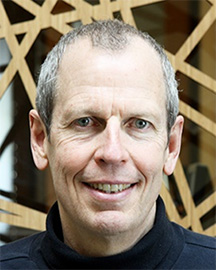Rockwood Memorial Lecture
2024
INC sponsors the H. Paul Rockwood Memorial Lectureship held annually. The Rockwood Memorial Lectureship Fund was gifted to the Institute by Mr. and Mrs. Jerome Rockwood in memory of their late son's interest, studies, and work in the neural computation field. The Rockwood Memorial Lectures are endowed by Mr. and Mrs. Jerome Rockwood in memory of their late son, Paul, who received a B.S. in Computer Science from UCSD in 1980 and then obtained a second degree B.A. in Psychology in 1981. In 1983 he started a company, Integral Solutions, to develop a universal language translation, but died tragically in a mountaineering accident before he could fulfill his promise.

John Doyle
Jean-Lou Chameau Professor of Control and Dynamical Systems and Bioengineering, California Institute of Technology
https://doyle.caltech.edu/
The Architecture of Brains
From Biology to Language, Technology, Sports, and Society
November 14, 2024
Time: 3:30 – 5:00 pm PDT
Location: Fung Auditorium, Powell-Focht Bioengineering Hall
University of California San Diego
Zoom: https://ucsd.zoom.us/j/2888083696
Abstract: The human brain's evolution, enabling language, technology, medicine, and society, encompasses bewilderingly diverse details and systems. Yet, all these advancements are facilitated by a shared Universal Layered Architecture (ULA). ULAs are pervasive because virtualization allows builders and users—including scientists and engineers—to grasp only fragments, while the architecture itself persists, evolves, and propagates. While ULAs usher in remarkable triumphs, they also harbor catastrophic vulnerabilities, exposing systems to pathogens, cancer, patriarchy, and the resulting pandemics and wars. ULAs thus remain perilously misunderstood. Beginning with sensorimotor control, this talk will outline ULA concepts such as Diversity-Enabled Sweet Spots (DeSS) and "constraints that deconstrain" via layers, levels, stages, the bowtie and hourglass models, and new laws on efficiency and robustness. Theory demonstrates that ULAs are necessary in overcoming biology's hardware layer constraints on sensing, communications, computing, and actions—such as sparsity, locality, saturation, and delays. This nascent theory also suggests enhancements in both understanding and design of ULAs. Examples range from cellular to societal scales, including successful animal models of social architectures from which humans could derive valuable lessons.
Bio: BSEE & MSEE, MIT (1977); PhD Mathematics, UC Berkeley (1984). He is most known for outstanding and forgiving students, colleagues, and family, and the shortest ever abstract in IEEE journals (and MSEE thesis at MIT). Research from 1976 was on robust control as a consultant in industry and since as an academic on mathematical foundations for a theory of architecture, with broad applications. Occasional hobbies are rigorous theories in multiscale physics, from turbulence to earthquakes. Individual awards include IEEE Power Hickernell and Control Systems Centennial and Field Awards, and world championships and records in various sports.
Click here to view the flier.
Hosted by: Terry Sejnowski, Ph.D. and Gert Cauwenberghs, Ph.D.
Organized by: Institute for Neural Computation, https://inc.ucsd.edu